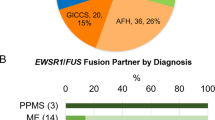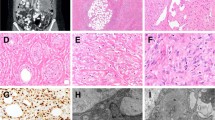Abstract
The identification of subtype-specific translocations has revolutionized the diagnostics of sarcoma and has provided new insight into oncogenesis. We used RNA-seq to investigate samples from individuals diagnosed with small round cell tumors of bone, possibly Ewing sarcoma, but which lacked the canonical EWSR1-ETS translocation. A new fusion was observed between BCOR (encoding the BCL6 co-repressor) and CCNB3 (encoding the testis-specific cyclin B3) on the X chromosome. RNA-seq results were confirmed by RT-PCR and through cloning of the tumor-specific genomic translocation breakpoints. In total, 24 BCOR-CCNB3–positive tumors were identified among a series of 594 sarcoma cases. Gene profiling experiments indicated that BCOR-CCNB3–positive cases are biologically distinct from other sarcomas, particularly Ewing sarcoma. Finally, we show that CCNB3 immunohistochemistry is a powerful diagnostic marker for this subgroup of sarcoma and that overexpression of BCOR-CCNB3 or of truncated CCNB3 activates S phase in NIH3T3 cells. Thus, the intrachromosomal X-chromosome fusion described here represents a new subtype of bone sarcoma caused by a newly identified gene fusion mechanism.
This is a preview of subscription content, access via your institution
Access options
Subscribe to this journal
Receive 12 print issues and online access
$209.00 per year
only $17.42 per issue
Buy this article
- Purchase on Springer Link
- Instant access to full article PDF
Prices may be subject to local taxes which are calculated during checkout





Similar content being viewed by others
Accession codes
References
Delattre, O. et al. Gene fusion with an ETS domain caused by chromosome translocation in human tumors. Nature 359, 162–165 (1992).
Delattre, O. et al. The Ewing family of tumors: a subgroup of small round cell tumors defined by specific chimeric transcripts. N. Engl. J. Med. 331, 294–299 (1994).
Toomey, E.C., Schiffman, J.D. & Lessnick, S.L. Recent advances in the molecular pathogenesis of Ewing's sarcoma. Oncogene 29, 4504–4516 (2010).
Szuhai, K. et al. The NFATc2 gene is involved in a novel cloned translocation in a Ewing sarcoma variant that couples its function in immunology to oncology. Clin. Cancer Res. 15, 2259–2268 (2009).
Broadhead, M.L., Clark, J.C., Myers, D.E. & Dass, C.R. The molecular pathogenesis of osteosarcoma: a review. Sarcoma 2011, 959248 (2011).
Wilhelm, B.T. et al. Dynamic repertoire of a eukaryotic transcriptome surveyed at single-nucleotide resolution. Nature 453, 1239–1243 (2008).
Mortazavi, A., Williams, B.A., McCue, K., Schaeffer, L. & Wold, B. Mapping and quantifying mammalian transcriptomes by RNA-Seq. Nat. Methods 5, 621–628 (2008).
Maher, C.A. et al. Chimeric transcript discovery by paired-end transcriptome sequencing. Proc. Natl. Acad. Sci. USA 106, 12353–12358 (2009).
Sboner, A. et al. FusionSeq: a modular framework for finding gene fusions by analyzing paired-end RNA-sequencing data. Genome Biol. 11, R104 (2010).
Peter, M., Gilbert, E. & Delattre, O. A multiplex real-time PCR assay for the detection of gene fusions observed in solid tumors. Lab. Invest. 81, 905–912 (2001).
Ng, T.L. et al. Ewing sarcoma with novel translocation t(2;16) producing an in-frame fusion of FUS and FEV. J. Mol. Diagn. 9, 459–463 (2007).
Huynh, K.D., Fischle, W., Verdin, E. & Bardwell, V.J. BCoR, a novel corepressor involved in BCL-6 repression. Genes Dev. 14, 1810–1823 (2000).
Gallant, P. & Nigg, E.A. Identification of a novel vertebrate cyclin: cyclin B3 shares properties with both A- and B-type cyclins. EMBO J. 13, 595–605 (1994).
Armengol, G. et al. Recurrent gains of 1q, 8 and 12 in the Ewing family of tumours by comparative genomic hybridization. Br. J. Cancer 75, 1403–1409 (1997).
Gearhart, M.D., Corcoran, C.M., Wamstad, J.A. & Bardwell, V.J. Polycomb group and SCF ubiquitin ligases are found in a novel BCOR complex that is recruited to BCL6 targets. Mol. Cell. Biol. 26, 6880–6889 (2006).
Fan, Z. et al. BCOR regulates mesenchymal stem cell function by epigenetic mechanisms. Nat. Cell Biol. 11, 1002–1009 (2009).
Ng, D. et al. Oculofaciocardiodental and Lenz microphthalmia syndromes result from distinct classes of mutations in BCOR. Nat. Genet. 36, 411–416 (2004).
Yamamoto, Y. et al. BCOR as a novel fusion partner of retinoic acid receptor α in a t(X;17)(p11;q12) variant of acute promyelocytic leukemia. Blood 116, 4274–4283 (2010).
Grossmann, V. et al. Whole genome sequencing identifies somatic mutations of BCOR in acute myeloid leukemia with normal karyotype. Blood 118, 6153–6163 (2011).
Nguyen, T.B. et al. Characterization and expression of mammalian cyclin b3, a prepachytene meiotic cyclin. J. Biol. Chem. 277, 41960–41969 (2002).
Kawamura-Saito, M. et al. Fusion between CIC and DUX4 up-regulates PEA3 family genes in Ewing-like sarcomas with t(4;19)(q35; q13) translocation. Hum. Mol. Genet. 15, 2125–2137 (2006).
R: A Language and Environment for Statistical Computing. (eds. Venables, W.N. & Smith, D.M.) (R Development Core Team, Vienna, 2005).
Culhane, A.C., Thioulouse, J., Perriere, G. & Higgins, D.G. MADE4: an R package for multivariate analysis of gene expression data. Bioinformatics 21, 2789–2790 (2005).
Subramanian, A. et al. Gene set enrichment analysis: a knowledge-based approach for interpreting genome-wide experssion profiles. Proc. Natl. Acad. Sci. USA 102, 15545–15550 (2005).
Tusher, V.G., Tibshirani, R. & Chu, G. Significance analysis of microarrays applied to the ionizing radiation response. Proc. Natl. Acad. Sci. USA 98, 5116–5121 (2001).
Huang, W. et al. Bioinformatics enrichment tools: paths toward the comprehensive functional analysis of large gene lists. Nucleic Acids Res. 37, 1–13 (2009).
Dauphinot, L. et al. Analysis of the expression of cell cycle regulators in Ewing cell lines: EWS-FLI-1 modulates p57KIP2 and c-Myc expression. Oncogene 20, 3258–3265 (2001).
Acknowledgements
We thank S. Chanock for fruitful discussions and critical reading of the manuscript. We are indebted to V. Raynal, P. Legoix-Ne, A. Nicolas, D. Gentien, S. Lair, A. Lermine and E. Barillot for critical technical help. We thank the following individuals for contributing cases and paraffin blocks or for supplying clinical information: J. Champigneulle, A. Croue, P. Dechelotte, J.M. Guinebretière, C. Jeanne-Pasquier, A. Moreau, J.M. Picquenot, D. Ranchère-Vince, X. Sastre-Garau, P. Terrier, M.C. Vacher-Lavenue, V. Verkaere and L. Guillou. We thank E. Louis, S. Thoraval and T. Scarcez from the Life Science Company for help in applying SOLiD technology. We also thank N. Bretschneider, C. Gugenmus, M. Scherf and M. Seifert from the Genomatix company for the analysis of data. This work was supported by grants from the Ligue Nationale Contre le Cancer (Equipe Labellisée and Carte d'ldentité des Tumeurs program), the Région Île de France, the Institut National du Cancer (INCa; 2008-044, 0627 and ZP09-027-EPI), the European Union (European Embryonal Tumors pipeline) and the following associations: Courir pour Mathieu, Dans les Pas du Géant, Olivier Chape, Les Bagouzamanon and Les Amis de Claire.
Author information
Authors and Affiliations
Contributions
S.B. performed the next-generation sequencing analysis. G.P., S.R. and S.B. characterized the initial case and screened the individuals with sarcoma. C.L. and F.T. performed all the bioinformatics analyses. J.-M.C. performed pathological review of the cases and CCNB3 immunohistochemistery experiments. S.C.-G. contributed the analysis of clinical files and, with V.P. performed the cloning and cell cycle analyses for BCOR-CCNB3 and ΔCCNB3 cDNA. G.P., F.T. and O.D. planned and supervised the work, and all authors contributed to writing the manuscript.
Corresponding author
Ethics declarations
Competing interests
The authors declare no competing financial interests.
Supplementary information
Supplementary Text and Figures
Supplementary Figure 1–6 (PDF 2159 kb)
Supplementary Tables
Supplementary Tables 1–10 (XLS 5206 kb)
Rights and permissions
About this article
Cite this article
Pierron, G., Tirode, F., Lucchesi, C. et al. A new subtype of bone sarcoma defined by BCOR-CCNB3 gene fusion. Nat Genet 44, 461–466 (2012). https://doi.org/10.1038/ng.1107
Received:
Accepted:
Published:
Issue Date:
DOI: https://doi.org/10.1038/ng.1107
This article is cited by
-
Aberrant gene activation in synovial sarcoma relies on SSX specificity and increased PRC1.1 stability
Nature Structural & Molecular Biology (2023)
-
Establishing an RNA fusions panel in soft tissue sarcoma with clinical validation
Scientific Reports (2023)
-
High-grade neuroepithelial tumor with EP300::BCOR fusion and negative BCOR immunohistochemical expression: a case report
Brain Tumor Pathology (2023)
-
BCOR-CCNB3 sarcoma with concurrent RNF213-SLC26A11 gene fusion: a rare sarcoma with altered histopathological features after chemotherapy
World Journal of Surgical Oncology (2022)
-
Rapid and highly sensitive approach for multiplexed somatic fusion detection
Modern Pathology (2022)



